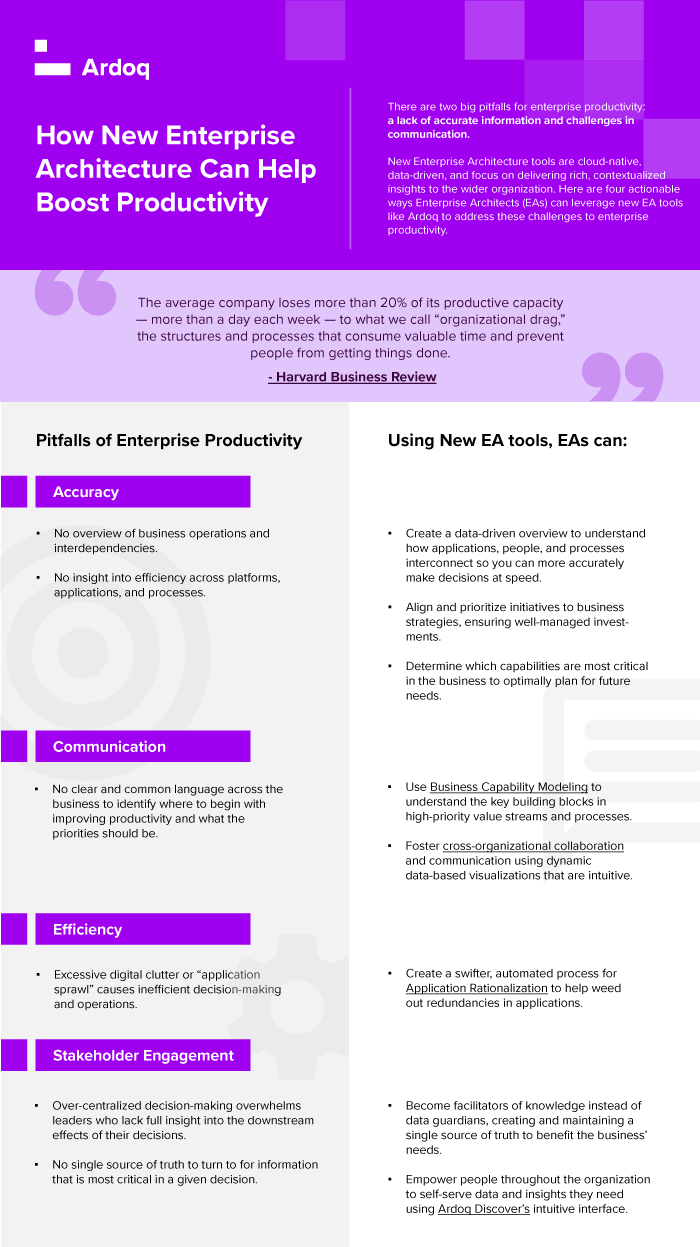It’s been over two years, yet countries and companies worldwide continue to navigate the pandemic and its aftereffects. Unfortunately, warnings of impending recessions are ringing louder than ever, and the economic outlook is grim. So while individuals can steel themselves with masks and vaccine boosters for the uncertain way forward, what can organizations do to immunize themselves against rising fuel prices and sluggish economic growth?
They can proactively look into leaner ways of working and more innovative approaches to improving enterprise productivity. It is too late when companies resort to hiring freezes and sudden layoffs to keep the lights on. The time is now to lay the groundwork for the inevitable tightening of budgets.
 Get your free copy of How Enterprise Architecture Can Help Boost Enterprise Productivity
Get your free copy of How Enterprise Architecture Can Help Boost Enterprise Productivity
Assess the State of Your Enterprise
First, organizations can and should look within to understand their actual state. Only then are they equipped to take the mission-critical step to understand how the organization is really operating and how effective it is across platforms, applications, and processes. Then focusing internally, they should investigate how to do more with existing or reduced resources. However, creating and maintaining an interconnected overview is where most organizations falter and where new Enterprise Architecture (EA) offers significant value. Enterprise Architecture can help you get an understanding of how:
- Applications, people, processes, and data interconnect in the business
- Initiatives align with the business’s strategy
- To better manage risk with key stakeholders through the organization
- The business’s capabilities are resourced and implemented
- To differentiate and mature the business’s capabilities
Where the early practice of Enterprise Architecture was more focused on manual documentation and IT governance, new EA seeks to structure business processes and capabilities to support an organization’s strategy. This overview and understanding offered by new EA can help organizations move and develop in a more aligned way. Here are some key dimensions where new EA helps organizations streamline and bolster productivity.
Streamline People and Processes
There is often no unified language or platform across the business to provide insight into how productive it really is as a whole. So when leadership is faced with an urgent need to streamline and improve productivity, they can find it challenging to accurately identify where to begin. There is no way to know where to optimize and improve without harming the organization’s ability to deliver the same value to its customers.
New EA is able to help businesses gain a structured, data-based understanding of how the business really operates and all the key building blocks that make up critical value streams or processes. It does this through Business Capability Modeling and Business Capability Realization, modeling people, processes, technology, and capabilities into one dynamic, data-based overview. This overview can also connect up to the business’s strategic goals, so the impact and alignment of projects can be seen more clearly across the organization. With this understanding, decision-makers can identify which capabilities are critical and which are less so, helping them to quickly identify processes or capabilities that need streamlining to maintain optimal efficiency in the present and future.
Reduce Digital Clutter and Improve Efficiency
Enterprises today, large and small, often have hundreds of applications used to run various aspects of the business. Many of them struggle with complex application portfolios full of duplicates with unclear ownership, further exacerbated by the rise of shadow IT. This problem, known as “application sprawl,” creates a lot of inefficiencies in the decision-making process and day-to-day operations. People are torn between more unintegrated applications than are really necessary for them to carry out their jobs effectively, leading to suboptimal use of resources. This complexity also means it takes much more time and resources to onboard and train new employees. For example, 37% of employees in the UK stated they have to do double the amount of work across multiple platforms because of poor technology that doesn’t integrate. This is massively time-consuming and frustrating on an individual level.
There is a clear business need to reign in these bloated and disconnected application portfolios, but the reason many organizations resist or fail is because the traditional process is lengthy, ineffective, and expensive. It involves the IT department combining hundreds of data sources, conducting interviews, manually collecting survey data, then mapping out the application portfolio in Powerpoint and profiling applications one by one. Usually, the analysis has to be done separately in Excel to get the final shortlist of applications that are ripe for retirement.
New digital-native EA tools can make this process of application rationalization much quicker, automating the data consolidation, processing, facilitating the crowdsourcing process, and producing actionable recommendations. We’ve seen that these tools can increase ROI and halve the time usually needed to get that final shortlist of applications. The trimmed-down application portfolio improves productivity, streamlines operations, helps new staff get onboarded more quickly as well as work more effectively overall.
Digital-First and Democratized Approach for Agile Decision-Making
Another key area of potential unproductivity and ineffectiveness is how organizations make decisions. Based on traditional, hierarchical structures, many enterprises maintain highly centralized command-and-control models for decision-making. This leads to executive decision-making becoming overcentralized, overwhelming decision-makers with the volume and speed of choices that need to be made on a daily basis. The person making the decisions over timelines and resource is often so far removed from the actual work that they lack the full understanding and information needed to make effective decisions. Yet the people on the ground with the domain knowledge lack the authority and mandate to make these decisions themselves. In addition, the technological complexity of current enterprises is such that very few people at any level in the organization have a clear overview of how everything is connected.
So then what is necessary to empower people to make informed decisions faster? They would need:
- A convenient access point to the most information most relevant to their decision
- A reliable source of data across the organization that is automatically kept up-to-date
- The ability to independently dive deeper into the details to back up their decision
- Dynamic visualizations of how people, processes, projects and technology are connected in their organization to understand the potential impact of each decision
- A way to contribute their own domain expertise to enrich and inform the decisions of others in the organization
This is precisely where new Enterprise Architecture tools excel with intuitive interfaces that move away from highly technical users and instead focus on enabling more people in the organization to self-serve the capabilities and insights they need. Democratized access to this overview improves the situational awareness of individuals in the enterprise while empowering them with contextual insights and visualizations tailored to their needs. Leadership can more easily delegate decision-making when they can trust that people will make decisions based on data and a unified view of the organization.
When decisions across the organization are made based on data-derived insights, the quality of decisions made and their alignment with the business increases drastically, making the journey to every choice more efficient and productive.
Key Takeaways on Boosting Enterprise Productivity With New EA:
- New EA can help you get a clear, interconnected overview of the organization to identify opportunities to improve and optimize.
- Use Business Capability Modeling and Business Capability Realization to find out what your critical capabilities are and how operationally effective they are.
- Swiftly find which applications you should retire or consolidate using Application Rationalization, reducing the digital clutter caused by application sprawl.
- Make informed decisions faster using the dynamic overview that new EA provides, leveraging its insights to understand the potential impact of every decision.
- Having access to this overview and the ability to self-serve insights also helps leadership entrust more decisions to others, easing the bottleneck around decision-makers in traditional, hierarchical organizational structures.
 Deborah Theseira
Deborah is a Senior Content Specialist at Ardoq. She wields words in the hope of demystifying the complex and ever-evolving world of Enterprise Architecture. She is excited about helping the curious understand the immense potential it has for driving effective change.
Deborah Theseira
Deborah is a Senior Content Specialist at Ardoq. She wields words in the hope of demystifying the complex and ever-evolving world of Enterprise Architecture. She is excited about helping the curious understand the immense potential it has for driving effective change.




/Logos/Ardoq/RGB_Ardoq_Logo_Stacked_White_Monochrome%201.png?width=80&height=77&name=RGB_Ardoq_Logo_Stacked_White_Monochrome%201.png)


